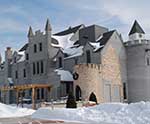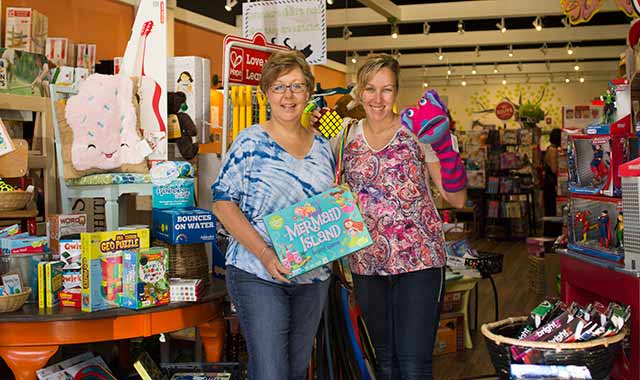Check out these unique destinations that reflect the genuine character of our region.
Donovan Street Bridge
1 W. Wilson St., downtown Batavia
Batavia’s Wilson Street Bridge is an important piece of the city’s architectural history.
Also known as the Donovan Bridge, this concrete and steel structure was reconstructed for the third time in 2008. The bridge it replaced spanned the Fox River since 1911. That bridge replaced the original structure, built in the mid-1800s.
“Early on, the bridge that was put in was just a wooden structure and over time, it began to wash away,” says Chris Winter, a curator at the Batavia Depot Museum. “When it was redone, it was made out of stone and concrete.”
Mayor Jeff Schielke says about 25,000 to 35,000 people pass over the bridge each day.
“It’s a pedestrian bridge with bike trails under it, and it’s named after Monsignor William Donovan, who was a priest in town,” he says.
Donovan was a priest at Holy Cross Catholic Church from 1929 until his retirement in 1967. He died in 1987 at the age of 102.
“He was very active in the Catholic Church and in our community, and he was involved in the Civil Rights movement,” Winter says. “That bridge was dedicated in his honor in 1984, when he celebrated his 100th birthday.”
Winter also says the bridge is the heart and soul of the city.
“It’s always connected the east and west sides of Batavia,” Winter says. “It’s been there since Batavia was founded, and when industries started coming here, everything flowed through that bridge. Everything in town centers around that bridge.”
Ravenstone Castle
4504 Illinois Route 23, Harvard, (815) 943-5764, ravenstonecastle.com
On the southern edge of Harvard sits a 16th century castle that resembles a relic from Camelot.
This is no medieval treasure, but it sure looks like one. Since 2008, the modern bed-and-breakfast at Ravenstone Castle has been a popular destination for quaint weddings, birthday parties and romantic getaways.
The 10-acre estate is also the dream home of Jose and Rose Michel. Rose has been in the European tapestry business for 23 years and is fascinated with Europe.
“We love traveling to Europe for the tapestry business, so we have been around a lot of this stuff,” Rose says. “It’s really neat that we can bring this here.”
The couple purchase tapestry fabric from Europe and create, among other things, their own wall hangings, pillows and table runners. Their work can be purchased at the castle during each of the four fairs held throughout the year.
Construction on the Michel’s dwelling lasted from 2001 to 2005. The castle’s 13 rooms are filled with unique antique pieces gathered from around the world.
Each room is decorated according to a theme, such as Queen Elizabeth, King Arthur and Egypt. Guests are invited to a European-style breakfast each morning.
Tours of the facility are given by appointment. To make an evening reservation, call Rose.
Yerkes Observatory
373 W. Geneva St., Williams Bay, Wis., (262) 245-5555,
If you want a closer view of outer space, visit Yerkes Observatory and experience the night sky through one of the world’s largest lens telescopes.
The University of Chicago Department of Astronomy and Astrophysics manages this 77-acre site, where the star attraction is a 40-inch diameter refractor telescope. Yerkes provides laboratory space and access to its telescopes for research and instruction.
In operation since 1897, Yerkes was established to watch and measure stellar motion through telescopes.
“Yerkes Observatory is the place where astrophysics really got started,” says Richard Dreiser, public information officer. “The University of Chicago remains one of the best places on Earth to get an education in astrophysics.”
In 1892, University astronomer George Hale discovered two optically perfect, 42-inch glass discs that had been intended for an observatory at the University of Southern California until funding fell through. Together with University president William Rainey Harper, Hale sought to purchase the orphaned lenses with help from Charles Yerkes, a Chicago businessman who’d made a fortune in the city’s electric railway.
Yerkes agreed; the lenses and their housing were built just in time to be displayed at the 1893 World’s Columbian Exposition in Chicago. After the World’s Fair, the telescope was moved to a permanent home in Williams Bay, on land offered to the University by a Chicago lawyer and real estate speculator.
Today, the public is invited for monthly observing sessions with Yerkes’ two telescopes.
“Typically, about 20 nights every month are reserved for observing programs, if weather permits,” Dreiser says.
Yerkes Observatory is open for tours now through May 24, every Mon.-Fri. 11 a.m.-2 p.m. It’s open Sat. 9:45 a.m.-1:30 p.m., with guided tours beginning at 10 a.m., 11 a.m. and noon. The full 2017 tour schedule will be released in March.




















































